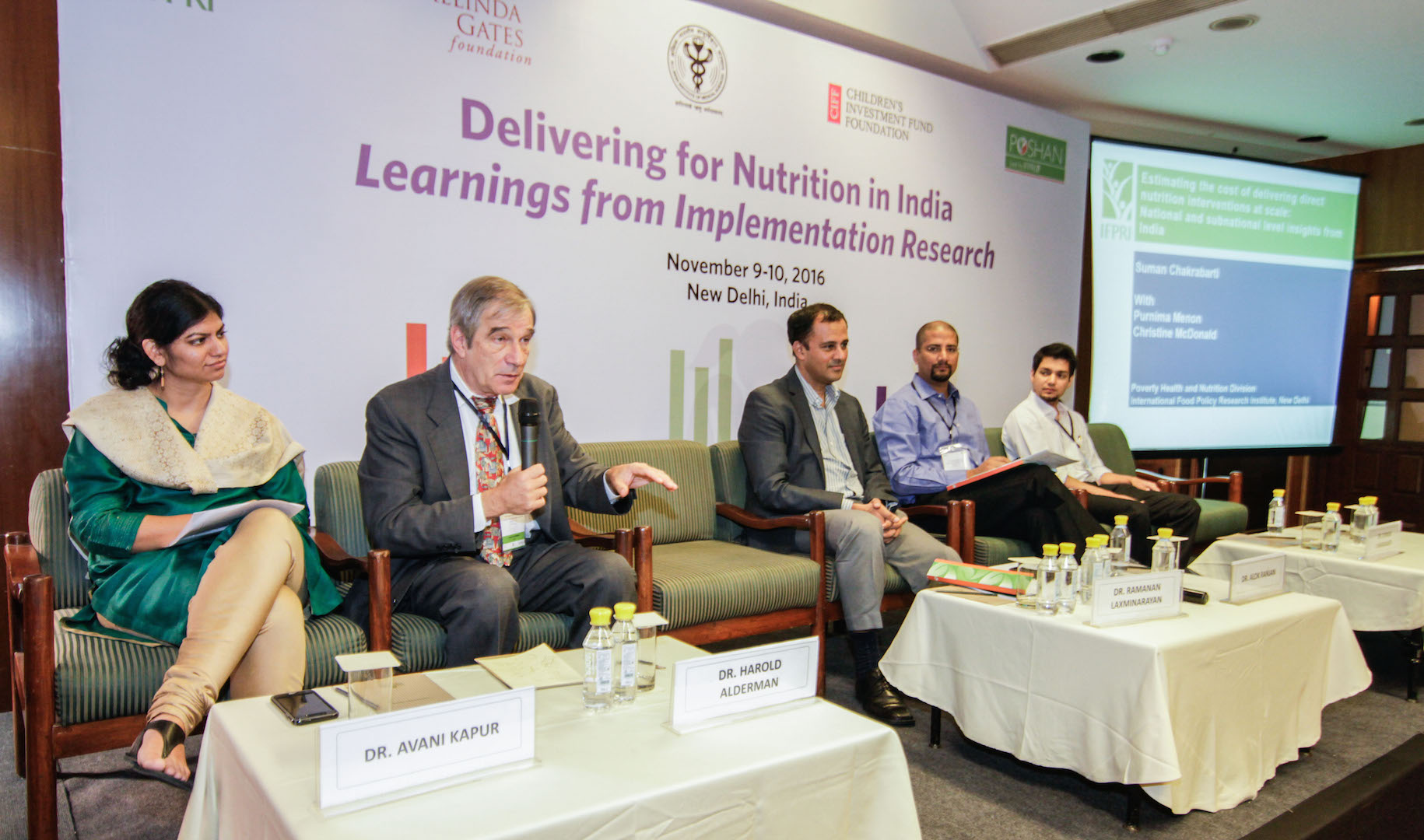 India carries an exceptionally high proportion of the global burden of undernutrition and is currently not on track to meet the World Health Assembly targets for stunting and anemia reduction. There is therefore an urgent need to invest in nutrition, in India. With this in mind, POSHAN’s implementation research conference “Delivering for Nutrition in India: Learnings from Implementation Research”, had a dedicated session on nutrition financing. The session which was chaired by Dr. Ramanan Laxminarayan from the Center for Disease Dynamics, Economics & Policy and Dr. Alok Ranjan from the Bill and Melinda Gates Foundation, shed light on the economic benefits from investing in nutrition, the potential costs of delivering direct nutrition interventions at scale, as well as budget and expenditure analyses for centrally sponsored schemes.
India carries an exceptionally high proportion of the global burden of undernutrition and is currently not on track to meet the World Health Assembly targets for stunting and anemia reduction. There is therefore an urgent need to invest in nutrition, in India. With this in mind, POSHAN’s implementation research conference “Delivering for Nutrition in India: Learnings from Implementation Research”, had a dedicated session on nutrition financing. The session which was chaired by Dr. Ramanan Laxminarayan from the Center for Disease Dynamics, Economics & Policy and Dr. Alok Ranjan from the Bill and Melinda Gates Foundation, shed light on the economic benefits from investing in nutrition, the potential costs of delivering direct nutrition interventions at scale, as well as budget and expenditure analyses for centrally sponsored schemes.
The session opened with Dr. Harold Alderman’s (IFPRI) presentation on ‘estimating the economic benefits of addressing undernutrition’. He presented aggregate budgetary costs of scaling up nutrition from Lancet 2013 which estimated that scaling up 10 proven interventions to cover 90% of the target population would reduce stunting by 20% and cost $9.6 billion per year. The World Bank however, recently updated this estimate to $10 billion per year with an accompanying benefit-cost ratio of $15 for every $1 spent. Subjecting this to a 6% discount rate yields a benefit-cost ratio of 26:1 due to gains attributable to trends in improvement in stunting from investing in education in South Asia between 2015 and 2030. He concluded by stressing that even with varying assumptions behind the benefit-cost models, the ratio remains high, and that these calculations do not include impact on anemia or mortality, so the returns are likely to be even higher.
Mr. Suman Chakrabarti (IFPRI) presented results from a study that estimated the cost of delivering direct nutrition interventions at scale in India. He showed that India has its own nationally mandated set of nutrition specific interventions that have their own financial implications and provided national and state-level cost estimates for 14 direct nutrition interventions that are already included in the policies of the government of India. He reported that a total of 43,000 crore INR ($ 6.6 billion) are required annually to scale-up all costed interventions in India. Maternity benefits (cash transfers) account for half of the total cost while supplementary food rations for pregnant and lactating women, and their children aged 0 to 3 years, account for 40 percent. This total cost averages to a cost of $144 per child per year. Mr. Chakrabarti also noted that the low cost interventions such as counseling, IFA, vitamin A supplementation, deworming and insecticide treated nets, should be prioritized to benefit from high benefit-cost ratios.
In her presentation, Ms. Avani Kapur from the Accountability Initiative, analysed budgets and expenditures for centrally sponsored schemes (CSS) addressing nutrition in India. While analysing state budgets she reported that centrally-sponsored schemes like the ICDS and NRHM make up a significant source of nutrition spending in India, and that state budgets are not always spent in one year. Tracking of centrally sponsored schemes show that there are disincentives for comprehensive planning, problems in last mile delivery and that funds are not spent wisely. Despite these various problems, there are opportunities in the light of Information and communications technology reforms and CSS reforms that are underway. She concluded by stressing that the international community needs to advocate with the Union and state governments to ensure effective nutrition financing.
To conclude the session, Dr. Yashodhara Rana from Results for Development (R4D) presented on nutrition financing in Rajasthan via video. The presentation analysed the multi-sectoral financing available for nutrition across all sectors and programmes; the resource needs and current financing, as well as the funding gap for scaling the national priority interventions costed by IFPRI. She showed that financing for nutrition-sensitive programmes is nearly nine times as large as that of nutrition-specific interventions, and could be better leveraged. Further, available financing is only 31 percent of the actual resources needed, implying a financial gap of 69 percent. Additionally, Rajasthan had significant challenges in fully utilising the allocated amounts. In conclusion, she recommended maximizing the impact of nutrition-specific programmes with increased funding and better utilisation of budgets, as well as expanding the impact of nutrition-sensitive sectors through maintaining momentum for nutrition and striving for a coordinated multi-sectoral nutrition response.
Overall, the session provided insights on the nutrition financing scenario in India and the importance of investing in nutrition.
Written by Suman Chakrabarti, IFPRI
Related resources:
POSHAN Research Note: A Review of Evidence-Based Interventions in Indian Nutrition Programs
POSHAN Report: Estimating the Cost of Delivering Direct Nutrition Interventions at Scale
POSHAN Policy Note: Achieving the 2025 World Health Assembly Targets for Nutrition in India: What Will It Cost?


